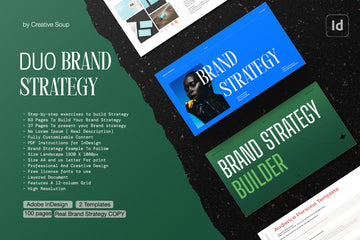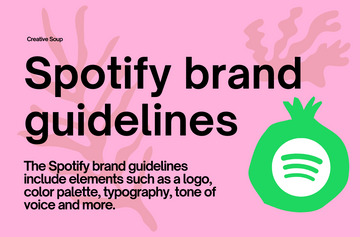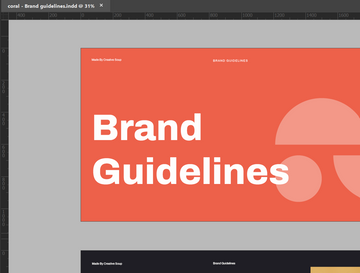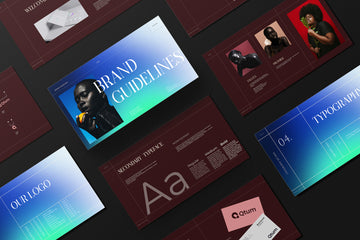Introduction
In the competitive field of graphic design, a strong brand strategy is essential for designers to stand out and attract their target audience. A well-crafted brand strategy serves as a roadmap, guiding designers in creating cohesive and impactful designs that effectively communicate their unique value proposition. In this article, we will explore the key components of a brand strategy template specifically tailored for graphic designers. By understanding these components and following a systematic approach, designers can develop a compelling brand strategy that resonates with their audience and helps them achieve their business goals.
Understanding the Importance of Brand Strategy
Before diving into the components of a brand strategy template, let's first understand why brand strategy is crucial for graphic designers. A well-defined brand strategy offers several benefits, including:
- Differentiation: In a crowded marketplace, a strong brand strategy helps designers differentiate themselves from competitors. It highlights their unique strengths, values, and aesthetic, making them more memorable and desirable to their target audience.
- Consistency: A brand strategy provides a framework for designers to create consistent and cohesive design experiences across various touchpoints. Consistency builds trust, reinforces brand recognition, and enhances the overall brand perception.
- Attracting the Right Clients: A clear brand strategy helps designers attract clients who align with their values and design philosophy. It allows designers to communicate their expertise, style, and the specific benefits they offer, attracting clients who appreciate and resonate with their work.
- Business Growth: A well-executed brand strategy contributes to business growth by enhancing brand awareness, fostering client loyalty, and generating positive referrals. It establishes a strong brand presence in the market, creating opportunities for increased visibility and client acquisition.
Key Components of a Brand Strategy Template
To create an effective brand strategy, graphic designers should consider the following key components:
Audience Personas
Understanding the target audience is crucial for designers to create a brand strategy that resonates with their ideal clients. Developing audience personas involves researching and identifying the characteristics, needs, motivations, and preferences of the target audience. By creating detailed personas, designers can tailor their brand messaging and design choices to engage and connect with their audience on a deeper level.
Competitor Research
Conducting thorough competitor research allows designers to gain insights into the strategies, strengths, and weaknesses of their competitors. By analyzing successful competitors in the design industry, designers can identify unique opportunities, differentiate themselves, and position their brand effectively. Competitor research helps designers understand market trends, audience expectations, and industry benchmarks.
Brand Positioning
Brand positioning defines the unique space a designer aims to occupy in the minds of their target audience. It involves identifying the designer's distinctive qualities, competitive advantages, and value proposition. By clearly positioning their brand, designers can differentiate themselves from competitors and establish a strong and memorable presence in the market.
Brand Story
A compelling brand story communicates the designer's journey, vision, and values. It humanizes the brand and creates an emotional connection with the audience. A well-crafted brand story showcases the designer's passion, expertise, and the problem they solve for their clients. It helps establish a strong brand identity and builds trust with the audience.
Brand Values
Defining brand values is essential for designers to articulate their guiding principles and the core beliefs that drive their work. Brand values reflect the designer's ethics, integrity, and the impact they aim to create through their designs. By aligning with the values of their target audience, designers can build credibility and attract clients who share similar values.
Brand Mission
A brand mission statement captures the designer's purpose and the impact they aspire to make through their designs. It conveys the broader vision and goals of the designer beyond the individual projects. A well-defined brand mission inspires both the designer and their clients, creating a sense of purpose and aligning their efforts towards a common goal.
Brand Touchpoints
Brand touchpoints refer to the various interactions and channels through which the audience engages with the designer's brand. This includes the website, social media profiles, client communications, and any other points of contact. Designers need to identify and optimize these touchpoints to ensure consistent brand messaging, visual identity, and user experience across all platforms.
Brand Messaging
Brand messaging involves crafting the key messages and positioning statements that effectively communicate the designer's value proposition and brand story. It includes taglines, slogans, and elevator pitches that encapsulate the essence of the brand. Consistent and compelling brand messaging helps designers communicate their unique strengths, benefits, and the problems they solve for their clients.
Tone of Voice
The tone of voice reflects the personality, style, and manner in which the designer communicates with their audience. It sets the overall impression and emotional tone of the brand's messaging. Whether it's formal, casual, playful, or authoritative, the tone of voice should align with the brand values, target audience, and desired brand perception.
Creating a Brand Strategy Template for Graphic Designers
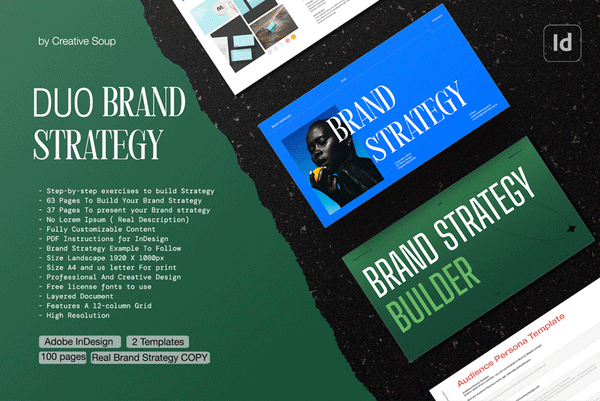
Now that we understand the key components of a brand strategy, let's explore the step-by-step process of creating a brand strategy template for graphic designers.
Developing Audience Personas
Start by researching and understanding the characteristics, needs, motivations, and preferences of your target audience. Create detailed audience personas that represent your ideal clients, including demographic information, professional backgrounds, challenges, and aspirations. These personas will serve as a foundation for tailoring your brand strategy and design choices.
Conducting Competitor Research
Analyze successful competitors in the design industry to gain insights into their branding strategies, target audience, design styles, and unique selling points. Identify gaps in the market, areas for differentiation, and opportunities to position yourself effectively. This research will help you refine your brand strategy and develop a distinct identity.
Defining Brand Positioning
Based on your research and competitor analysis, define your brand positioning. Identify your unique strengths, values, and design philosophy that set you apart from competitors. Clearly articulate your value proposition and the specific benefits you offer to your clients. Position yourself in a way that appeals to your target audience and aligns with their needs and aspirations.
Crafting a Compelling Brand Story
Tell your brand story in a way that captures the essence of your journey, vision, and values. Highlight the key milestones, challenges, and inspirations that have shaped your design career. Share your passion, expertise, and the problem you solve for your clients. Craft a story that creates an emotional connection with your audience and differentiates you from others.
Establishing Brand Values and Mission
Define your brand values and mission statement that reflect your guiding principles and the impact you aim to make through your designs. Clearly articulate the values that drive your work and the broader purpose of your brand. Communicate your vision and goals to inspire both yourself and your clients, creating a sense of purpose and shared values.
Identifying Brand Touchpoints
Identify the various touchpoints through which your audience interacts with your brand. This includes your website, social media profiles, portfolio, email communications, and any other points of contact. Ensure that each touchpoint reflects your brand's visual identity, messaging, and user experience consistently. Optimize these touchpoints to provide a cohesive and memorable brand experience.
Creating Consistent Brand Messaging
Craft key messages, taglines, and positioning statements that effectively communicate your value proposition, brand story, and unique selling points. Ensure consistency in your messaging across different channels and touchpoints. Clearly articulate the benefits you offer, the problems you solve, and the values you represent. Engage your audience with compelling and persuasive messaging.
Determining the Tone of Voice
Define the tone of voice that aligns with your brand values, target audience, and desired brand perception. Whether it's friendly, professional, authoritative, or playful, ensure that your tone of voice resonates with your audience and reflects your brand's personality. Consistency in tone of voice helps establish a strong brand identity and fosters audience engagement.
Implementing and Evolving the Brand Strategy
Implementing a brand strategy is an ongoing process that requires consistent effort and evaluation. Consider the following steps:
Consistency across Brand Touchpoints
Ensure consistency in visual identity, messaging, and user experience across all brand touchpoints. This includes your website, social media profiles, portfolio, and client communications. Consistent branding fosters recognition, trust, and a cohesive brand experience for your audience.
Continuous Monitoring and Evaluation
Regularly monitor the performance of your brand strategy by tracking key performance indicators (KPIs) such as brand awareness, client acquisition, client satisfaction, and project success rates. Analyze the data and gather feedback to evaluate the effectiveness of your strategy and identify areas for improvement.
Adapting the Strategy based on Insights
Based on your monitoring and evaluation, make necessary adjustments and adaptations to your brand strategy. Stay open to feedback, market trends, and changing audience preferences. Continuously refine your strategy to ensure it remains relevant, resonates with your audience, and aligns with your evolving business goals.
Tips for Effective Brand Strategy Implementation
To ensure the successful implementation of your brand strategy, consider the following tips:
Align Brand Strategy with Design Choices
Ensure that your brand strategy guides your design choices, including color palette, typography, imagery, and overall visual identity. Consistency between your brand strategy and design elements helps reinforce your brand perception and creates a memorable brand experience for your audience.
Engage and Collaborate with Clients
Involve your clients in the brand strategy implementation process. Seek feedback, understand their needs and preferences, and collaborate closely to ensure that your design choices align with their expectations. Engaging clients fosters a sense of ownership and strengthens the client-designer relationship.
Regularly Assess Brand Performance
Continuously monitor the performance of your brand strategy by tracking key metrics and gathering client feedback. Regularly assess the effectiveness of your strategy in achieving your business goals. Identify areas of improvement and make necessary adjustments to enhance brand performance and audience engagement.
Stay Open to Adaptation and Evolution
The design industry is dynamic and constantly evolving. Stay open to new trends, emerging technologies, and changing audience preferences. Adapt your brand strategy accordingly to remain relevant and ahead of the competition. Embrace innovation and be willing to explore new design approaches that align with your brand's core values.
Conclusion
A strong brand strategy is a critical tool for graphic designers to establish their identity, attract their target audience, and drive business growth. By understanding and implementing the key components of a brand strategy template, designers can create a compelling and differentiated brand presence in the competitive design industry. Through audience personas, competitor research, brand positioning, brand story, brand values, brand mission, brand touchpoints, brand messaging, and tone of voice, designers can shape their brand strategy to effectively communicate their unique value proposition and connect with their audience.
It is important for designers to continuously monitor and evaluate the performance of their brand strategy, making necessary adjustments to stay relevant and responsive to market trends and audience preferences. By maintaining consistency across brand touchpoints, engaging with clients collaboratively, regularly assessing brand performance, and embracing adaptation and evolution, designers can ensure the long-term effectiveness of their brand strategy.
Remember, a well-crafted brand strategy is not only about visuals and messaging but also about creating an emotional connection with the audience. It is the story, values, and mission behind the brand that resonate with clients and differentiate designers from the competition.
By following the guidelines and incorporating the tips provided in this article, graphic designers can create a strong brand strategy that sets them apart, attracts their ideal clients, and establishes a foundation for success in the dynamic world of graphic design.
Get Due Brand Strategy Template Now
FAQs
Q1: How long does it take to develop a brand strategy?
The timeline for developing a brand strategy can vary depending on the complexity of the designer's target audience, market research requirements, and the level of detail desired. It typically takes several weeks to thoroughly research, define key components, and craft a robust brand strategy.
Q2: Can a brand strategy be revised or updated?
Yes, a brand strategy should be viewed as a living document that can be revised or updated over time. As the market evolves, audience preferences change, or the designer's goals shift, it is important to review and adapt the brand strategy accordingly to ensure its continued relevance and effectiveness.
Q3: Is a brand strategy only important for large design agencies?
No, a brand strategy is crucial for graphic designers of all sizes, including freelancers and small design studios. Regardless of their scale, a well-defined brand strategy helps designers differentiate themselves, attract clients, and create consistent and impactful design experiences.
Q4: How can I measure the effectiveness of my brand strategy?
Measuring the effectiveness of a brand strategy can be done by monitoring key performance indicators (KPIs) such as client acquisition, client satisfaction, brand recognition, and project success rates. Regularly analyzing these metrics can provide insights into the impact of the brand strategy and guide future adjustments.
Q5: Can a graphic designer have multiple brand strategies for different target audiences?
Yes, it is possible for a graphic designer to have multiple brand strategies if they cater to different target audiences or offer distinct services. Each brand strategy should be tailored to the specific audience or service, ensuring consistency within each strategy while maintaining differentiation between them.
